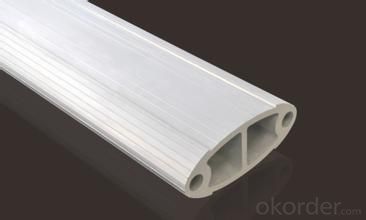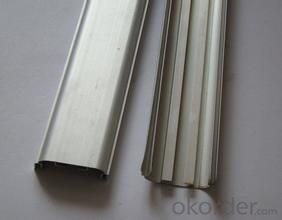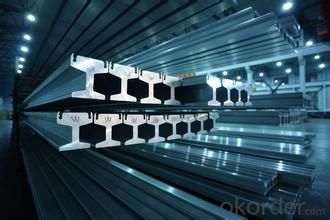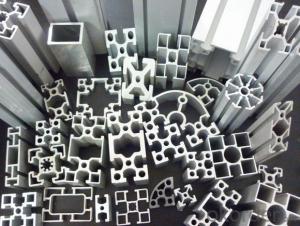Aluminium Profile for Marine Ship Deck Making
- Loading Port:
- Shanghai
- Payment Terms:
- TT OR LC
- Min Order Qty:
- 5 m.t.
- Supply Capability:
- 1000 m.t./month
OKorder Service Pledge
OKorder Financial Service
You Might Also Like
Item specifice
1. Structure of Aluminium Profile for Marine Ship Deck Making Description
Aluminium Profile for Marine Ship Deck Making is one semi-finished aluminium material. The alloy AA5083 T6 is widly used in building, industry ect. Its weight is much lower than steel. So many customers choosed aluminium material instead of steel.
2. Specification of Aluminium Profile for Marine Ship Deck Making
Aluminum Extrusion | |
Main Specification | |
Alloy | AA1xxx (AA1050, AA1060, AA1070, AA1100 etc.) |
AA3xxx (AA3003, AA3004, AA3005, AA3105 etc.) | |
AA5xxx, AA6XXX (AA5052,AA5083, AA5754, AA6061, AA6062 etc.) | |
AA8xxx(AA8011, AA8006 etc.) | |
Temper | H14,H16, H18, H22, H24, H26, H32,O/F, T4, T6, T651 |
Thickmess | 0.01mm-100mm |
Width | 30mm-1700mm |
Standard | GB/T 3880-2006/ASTM |
Special specification is available on customer's requirement | |
3. Application of Aluminium Profile for Marine Ship Deck Making
(1).Interior: wall cladding, ceilings, bathrooms, kitchens and balconies, shutters, doors...
(2).Exterior: wall cladding, facades, roofing, canopies, tunnels,column covers , renovations...
(3).Advertisement: display platforms, signboards, fascia, shop fronts...
4. Feature of Aluminium Profile for Marine Ship Deck Making
Surfact Quality :
Be free from Oil Stain, Dent, Inclusion, Scratches, Stain, Oxide Dicoloration, Breaks, Corrosion, Roll Marks, Dirt Streaks and other defect which will interfere with use,
Mechenical Property:
Chemical Composite and Mechanical Property
5. Certificate of Aluminium Profile for Marine Ship Deck Making
SGS and ROHS(if client request, paid by client), MTC(plant provided), Certificate of Origin(FORM A, FORM E, CO), Bureau Veritas and SGS (if client request, paid by client), CIQS certificate
6. Image of Aluminium Profile for Marine Ship Deck Making



7. Package and shipping of Aluminium Profile for Marine Ship Deck Making
First, plastic cloth with drying agent inside; Second, Pearl Wool ; Third, wooden cases with dry agent , fumigation wooden pallets, aluminum surface could cover blue PVC film
8. FAQ
1) What is the delivery time?
Depends on actual order, around 20 to 35 days
2) What is the QC system:
We have QC staff of 20 persons and advanced equipment, each production is with MTC traced from Aluminum ingot lot.
3) What market do you mainly sell to?
Australia, America, Asia, Middle East, Western Europe, Africa etc
- Q:Can aluminum profiles be used in green building projects?
- Yes, aluminum profiles can be used in green building projects. Aluminum is a highly sustainable material as it is 100% recyclable and has a low carbon footprint. Additionally, aluminum profiles offer various benefits such as durability, versatility, and energy efficiency, making them suitable for green building practices.
- Q:Can aluminum profiles be used for safety barriers or guardrails?
- Yes, aluminum profiles can be used for safety barriers or guardrails. Aluminum is a lightweight yet strong material that offers good durability and resistance to corrosion. It can be easily fabricated into various shapes and sizes, making it suitable for constructing safety barriers or guardrails in different settings such as roads, construction sites, or industrial facilities. Additionally, aluminum profiles can be easily installed and maintained, making them a practical choice for safety applications.
- Q:How to deal with the mechanical surface of aluminum profile?
- Mechanical texture removal also has mechanical methods, chemical methods can not remove deeper texture, if sand blasting effect is acceptable, you try sand blasting or shot peening
- Q:What are the different welding options available for aluminum profiles?
- Some of the different welding options available for aluminum profiles include tungsten inert gas (TIG) welding, metal inert gas (MIG) welding, friction stir welding, and laser welding. Each method has its own advantages and is suitable for different applications and thicknesses of aluminum profiles. TIG welding provides precise control and is commonly used for thin aluminum profiles, while MIG welding is faster and more suitable for thicker profiles. Friction stir welding is a solid-state joining process that can create high-quality welds with minimal distortion. Laser welding offers high energy density and is often used for precision welding of aluminum profiles.
- Q:Are aluminum profiles suitable for historical or heritage restoration projects?
- Historical or heritage restoration projects can benefit from the use of aluminum profiles. Aluminum, being a versatile material, offers numerous advantages for such projects. Firstly, it can be manufactured to replicate traditional architectural features and designs, seamlessly integrating and preserving the historical aesthetics. In addition, aluminum is lightweight, making it easier to handle and install, especially in complex or intricate restoration projects. It is also highly durable and resistant to corrosion, which is vital for maintaining the structural integrity and longevity of historical buildings or structures. Moreover, aluminum profiles can be easily customized and fabricated to meet the specific requirements of historical restoration projects. They can be shaped, cut, and finished to resemble the original architectural elements, such as windows, doors, trim, or decorative features. Furthermore, aluminum profiles offer excellent thermal performance, improving energy efficiency and insulation in restored buildings. This leads to reduced energy consumption, lower heating or cooling costs, and enhanced overall comfort. Although wood or steel have been commonly used in historical restoration projects, aluminum profiles provide a contemporary alternative that combines aesthetic appeal, durability, and sustainability. However, it is crucial to ensure that the use of aluminum profiles aligns with the preservation guidelines and regulations of the specific historical or heritage project. In conclusion, aluminum profiles are a suitable choice for historical or heritage restoration projects due to their versatility, durability, lightweight nature, customization options, and energy efficiency. They successfully blend modern functionality with historical aesthetics, contributing to the preservation and revitalization of our architectural heritage.
- Q:What are the durability characteristics of aluminum profiles?
- Aluminum profiles are known for their excellent durability characteristics. They have a high strength-to-weight ratio, allowing them to withstand heavy loads without deforming or breaking. Additionally, aluminum is highly resistant to corrosion, making it suitable for both indoor and outdoor applications. The material is also non-combustible, providing added safety in case of fire. Overall, aluminum profiles offer long-lasting performance and are an ideal choice for various structural and architectural purposes.
- Q:Are aluminum profiles suitable for food processing or storage facilities?
- Yes, aluminum profiles are suitable for food processing or storage facilities. Aluminum is a highly versatile material that offers several advantages in these environments. Firstly, aluminum is corrosion-resistant, ensuring that it remains unaffected by moisture, food acids, or cleaning agents commonly used in food facilities. This makes it ideal for use in areas where hygiene and cleanliness are crucial. Secondly, aluminum profiles are lightweight yet sturdy, making them easy to handle and install. This is especially beneficial in food processing facilities where regular equipment maintenance and reconfigurations are required. Additionally, aluminum is a non-toxic material, ensuring that it does not contaminate food products during processing or storage. It is also an excellent conductor of heat, allowing for efficient temperature control in processing facilities. Furthermore, aluminum profiles can be easily cleaned and sanitized, reducing the risk of bacterial growth and ensuring compliance with food safety regulations. Overall, the durability, corrosion resistance, lightweight nature, non-toxicity, and ease of maintenance make aluminum profiles an excellent choice for food processing or storage facilities.
- Q:Can aluminum profiles be used in signage and display applications?
- Yes, aluminum profiles can definitely be used in signage and display applications. Aluminum is a lightweight and versatile material that offers many benefits for these purposes. It is durable, corrosion-resistant, and can withstand various weather conditions, making it suitable for both indoor and outdoor applications. Aluminum profiles can be easily customized in terms of shape, size, and finish, allowing for the creation of unique and eye-catching signs and displays. Additionally, aluminum profiles can be easily assembled and disassembled, making them convenient for transportation and installation. Overall, aluminum profiles provide a great solution for signage and display applications due to their durability, versatility, and aesthetic appeal.
- Q:What are the different extrusion processes used for aluminum profiles?
- Aluminum profiles can be produced using various extrusion processes, each with its own advantages and applications. The most commonly used processes for aluminum profiles are as follows: 1. Direct extrusion: This process involves forcing a heated aluminum billet through a die to form the desired shape. It is widely used and efficient, offering cost-effectiveness and the ability to produce profiles with consistent cross-sections, ranging from simple to complex. 2. Indirect extrusion: In this process, the billet remains stationary while the die moves, pushing the aluminum through the die to create the profile. Indirect extrusion is preferred when intricate internal features, higher surface finish, and tighter tolerances are required. 3. Impact extrusion: Specialized in creating hollow aluminum profiles like tubes or containers, impact extrusion involves placing an aluminum slug in a die and driving a punch into it. The slug flows around the punch to form the desired shape, making it suitable for thin-walled profiles with complex shapes. 4. Hydrostatic extrusion: This cold extrusion process utilizes high-pressure liquid to force the aluminum billet through a die. It is commonly used for producing high-strength profiles with improved mechanical properties and dimensional accuracy. 5. Hot extrusion: The aluminum billet is heated above its recrystallization point and then forced through a die in hot extrusion. This process is ideal for complex-shaped profiles, as the elevated temperature allows for better material flow and deformation. Each extrusion process offers unique benefits and is selected based on the specific requirements of the aluminum profile. Factors such as shape, complexity, surface finish, tolerances, and mechanical properties all play a crucial role in determining the most suitable extrusion process.
- Q:Can aluminum profiles be used in the construction of exhibition stands?
- Yes, aluminum profiles can be used in the construction of exhibition stands. Aluminum profiles are lightweight, versatile, and easy to work with, making them a popular choice for constructing exhibition stands. They can be easily shaped and customized to fit specific design requirements, and their durability ensures a long-lasting structure. Additionally, aluminum profiles can be powder-coated or anodized to provide a professional and attractive finish, enhancing the overall aesthetic appeal of the exhibition stand.
1. Manufacturer Overview |
|
|---|---|
| Location | |
| Year Established | |
| Annual Output Value | |
| Main Markets | |
| Company Certifications | |
2. Manufacturer Certificates |
|
|---|---|
| a) Certification Name | |
| Range | |
| Reference | |
| Validity Period | |
3. Manufacturer Capability |
|
|---|---|
| a)Trade Capacity | |
| Nearest Port | |
| Export Percentage | |
| No.of Employees in Trade Department | |
| Language Spoken: | |
| b)Factory Information | |
| Factory Size: | |
| No. of Production Lines | |
| Contract Manufacturing | |
| Product Price Range | |
Send your message to us
Aluminium Profile for Marine Ship Deck Making
- Loading Port:
- Shanghai
- Payment Terms:
- TT OR LC
- Min Order Qty:
- 5 m.t.
- Supply Capability:
- 1000 m.t./month
OKorder Service Pledge
OKorder Financial Service
Similar products
New products
Hot products
Hot Searches
Related keywords






























